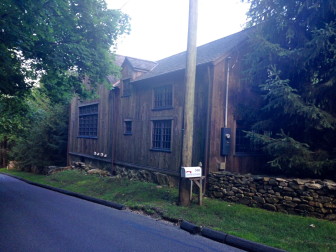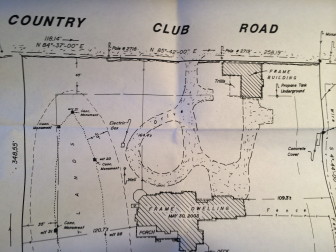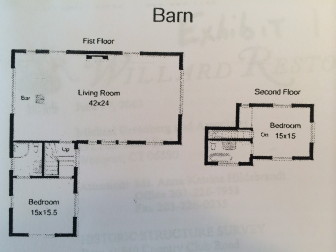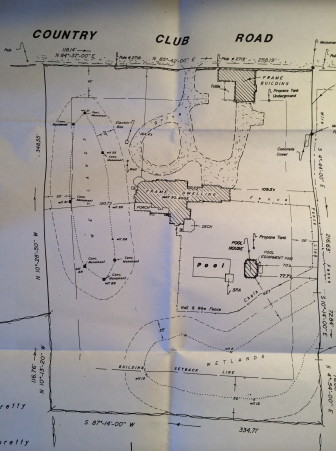The owners of a Country Club Road home on Monday night took an important first step toward winning town approval for an effort to re-designate as a guesthouse a barn on their 3.8-acre property that dates to the early 19th Century.

This ca. 1835 barn is part of a 3.8-acre property on Country Club Road. Its owners are planning to sell and are seeking approval to convert it into a guesthouse. Credit: Terry Dinan
David and Shelley Simone at number 340—the first driveway on the right as you come off of Oenoke Ridge—are planning to put their home on the market, New Canaan-based attorney David Rucci, representing the couple, said during a public hearing before the Zoning Board of Appeals.
Most of those who have seen the property—it includes a 7,000-square-foot home built in 2003, as well as a pool and spa—have asked whether the ca. 1835 two-story barn that sits right on the road is a guesthouse, Rucci said.

That’s the house at the bottom of this cropped rendering of the property at 340 Country Club Road. The barn in question, which dates to about 1835, officials say, is at the top and is right on top of the road—a feature that is true to our area’s heritage, according to a 2003 survey of the property.
“It’s basically being used as a guesthouse, but it’s not legally a guesthouse—and that’s OK, because right now it doesn’t have a kitchen, and that’s the barometer for determining whether it’s a guesthouse or not—so right now they don’t have it legally, but they want a legal residence,” Rucci said during the hearing, held in the Douglas Room at Lapham Community Center. “They want it to be a legal guesthouse and not this sort of nebulous thing.”
Before getting that designation by way of a Special Permit from the Planning and Zoning Commission, Rucci and the Simones needed the ZBA to except them from a zoning regulation that governs preservation of historic structures. Written out on page 139 here, the rule as applied in this case essentially would limit the Simones’ ability to convert the barn into a guesthouse because the structure itself is right on the property line (rather than within 75 percent of the setback—see the rule).

The floor plan of the barn itself.
Noting that an old barn with no use is more likely to be torn down, the board, chaired by Carroll Yanicelli, voted 5-0 in favor of the variance.
Said ZBA Secretary Jeanne Rozel: “I am in favor of letting them keep barn and the use, the hardship being that it’s on the road, [which] creates a zoning problem.”
P&Z next meets on Aug. 26.
The three neighbors of the Simones who would be directly affected by a re-designation all have written letters in support of the effort.
The barn had been under threat of demolition in 2003 (when the house was built), Rucci said, when a prior owner had renovated it and—at the time—it put the then-homeowners over coverage. The builder physically had started taking down the barn when he was asked to stop and the homeowner was granted a variance for the coverage—but not for conversion to a guesthouse, Rucci said. (A kitchen that had been installed was removed, Rucci said.)

Here’s the entire lot at 340 Country Club Road, which gives better perspective on its size and the relative position of the house and barn.
Two years later, in 2005, New Canaan’s zoning regulations changed in two important ways for the barn. First, they allowed for more coverage on the lot. And second, Rucci said: “The regs have all changed to really support people in holding onto the barn, and one of the things that they say is you can turn it into a guesthouse, you can turn it into a greenhouse, do things so that people save barns, so that they don’t tear them down.”
Town Planner Steve Kleppin said that a barn with such a new, flexible use adds value to a property, often preempting a desire to demolish.
A 2003 survey of the barn from Wethersfield-based Willard Restoration Inc. describes the structure as a “three-bay Connecticut barn, typical of its period and location.”
“Like many barns of its period it was located on a hillside so that main floor and the full cellar were accessible to wagons and farm animals from grade,” the Willard survey said.
“While the foundation is almost completely covered up, a few openings reveal fieldstone foundation laid up in mortar. Unless evidence to the contrary appears, we have no reason to think that this is not its original location. Barns were located away from the house to minimize odors and close to the road to minimize a long muddy approach drive. Its proximity to the road was worsened at the turn of the century when a six-foot addition was added at the end.”
The barn’s frame is hand-hewn chestnut, the Willard survey said, “with the exception of the diagonal braces, which are sawn oak.”
The property at 340 Country Club Road last sold in February 2005 for $6,875,000, tax records show.